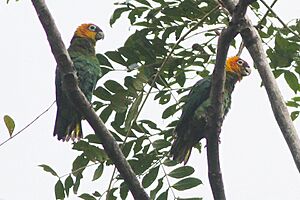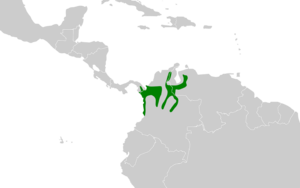Saffron-headed parrot facts for kids
Quick facts for kids Saffron-headed parrot |
|
|---|---|
 |
|
| Conservation status | |
| Scientific classification | |
| Genus: |
Pyrilia
|
| Species: |
pyrilia
|
 |
|
| Synonyms | |
|
|
The saffron-headed parrot (Pyrilia pyrilia) is a colorful bird found in parts of South and Central America. It belongs to the parrot family, Psittacidae. This species is considered Near Threatened, which means its population is decreasing and needs protection. You can find these parrots in countries like Colombia, Panama, and Venezuela.
Contents
About the Saffron-headed Parrot
Naming and Family Tree
The saffron-headed parrot is part of a group of birds called Pyrilia. Until recently, it was grouped with the pileated parrot in a different genus called Pionopsitta. This parrot is a unique species, meaning it does not have different subspecies.
What It Looks Like
This parrot is about 22 to 24 centimeters (around 9 inches) long. Adult saffron-headed parrots have a bright yellow head and neck. They have a white ring of skin around their eyes. Their chest is olive green, which forms a thin line around the back of their neck.
Most of their body is green. They have yellow feathers on their shoulders and red feathers on their sides and lower thighs. Their main wing feathers are dark, and their tail feathers have blue tips. Young parrots look a bit different. They have green heads, shoulders, and wing feathers instead of yellow or red.
Where It Lives
The saffron-headed parrot lives in eastern Darién Province in Panama. It also lives in northern and central Colombia, and northwestern Venezuela. These parrots prefer to live inside and at the edges of wet forests. They can be found in both old, untouched forests and newer, regrown forests. They usually live in areas below 900 meters (about 3,000 feet) in elevation. Sometimes, they might move to higher cloud forests, up to 1,650 meters (about 5,400 feet), but this might only be for certain seasons.
Parrot Behavior
Movement and Travel
Saffron-headed parrots usually stay in one area. However, they might move to different elevations depending on the season. They also sometimes roam around, but they don't travel very far.
What They Eat
Scientists don't know much about what saffron-headed parrots eat or how they find their food. More research is needed to understand their diet.
Reproduction
In Colombia, saffron-headed parrots lay their eggs and raise their young between March and June. Beyond this, not much is known about how they reproduce or build their nests.
How They Communicate
The most common sounds saffron-headed parrots make are "cureek" or "queek" calls. They make these loud, shrieking sounds both when they are sitting on a branch and when they are flying. They also make "piercing, hoarse-sounding calls" when they are perched.
Conservation Status
The IUCN (International Union for Conservation of Nature) first listed the saffron-headed parrot as "Vulnerable." But in 2007, they changed its status to "Near Threatened." This means the species is still at risk, but not as severely as before.
There are fewer than 20,000 adult saffron-headed parrots left, and their numbers are still going down. The biggest danger to these parrots is the loss of their forest homes. Forests are being cut down or damaged. People also sometimes catch these parrots to sell as pets. In some areas, like Venezuela's Serranía del Perijá, they are hunted for food.
Even though some parrots live in protected areas, much of their habitat is outside these safe zones. The places where these parrots like to live are also often good for farming and human settlements, which leads to more habitat loss. Protecting their forest homes is very important for their survival.


